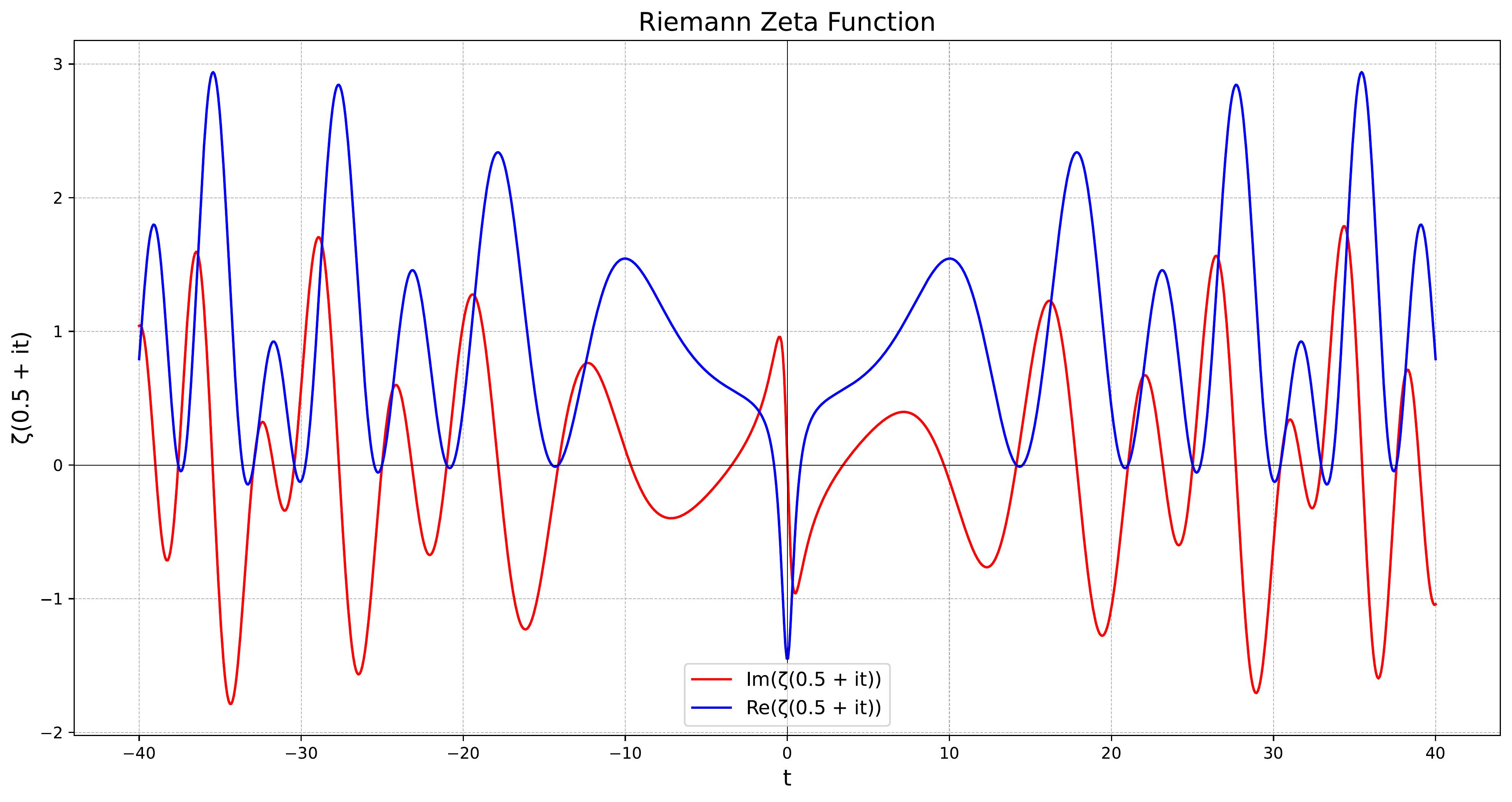Riemann hypothesis
Riemann zeta function and its zeros
Riemann zeta function
The Riemann zeta function is defined as
\begin{equation}\label{eq.zeta1} \zeta(z) = 1+\frac{1}{2^z}+\frac{1}{3^z} + \frac{1}{4^z}+\frac{1}{5^z}+\dots = \sum_{n=1}^\infty \frac{1}{n^{z}}. \end{equation}
The Riemann zeta function is connected to prime numbers through the Euler product representation: \begin{equation} \zeta(z) = \prod_{p \in \mathbb{P}} \frac{1}{1-p^{-z}}, \quad \mathbb{P} = {2,3,5,7,11,13,17,19,\dots }, \end{equation} \(\mathbb{P}\) is the set of prime numbers.
The proof of the Euler product expansion is quite simple and elegant. Firstly, let’s multiply the Riemann zeta function by \(\frac{1}{2^z}\) \begin{equation} \frac{1}{2^z} \zeta(z) = \frac{1}{2^z}+ \frac{1}{4^z}+\frac{1}{6^z} + \frac{1}{8^z} \dots \end{equation} Subtract it from the Rzf \begin{equation} \left(1- \frac{1}{2^z} \right) \zeta(z) = 1+\frac{1}{3^z} +\frac{1}{5^z}+ \frac{1}{7^z} + \frac{1}{9^z} + \frac{1}{11^z} + \dots. \end{equation} we see that all multiples of 2 are gone. Multiplying the result by \(\frac{1}{3^z}\): \begin{equation} \frac{1}{3^z}\left(1- \frac{1}{2^z} \right) \zeta(z) = \frac{1}{3^z} +\frac{1}{9^z}+ \frac{1}{15^z}+ \frac{1}{21^z} + \frac{1}{27^z} + \frac{1}{33^z} + \dots, \end{equation} and subtracting again we have \begin{equation} \left(1- \frac{1}{3^z} \right)\left(1- \frac{1}{2^z} \right) \zeta(z) = 1+ \frac{1}{5^z}+ \frac{1}{7^z}+ \frac{1}{11^z} + \frac{1}{13^z} + \frac{1}{17^z} + \dots, \end{equation} and now all the terms multiple of 3 are gone. If we keep multiply by \(1/p^z\) where \(p\) is a prime number, we will eventually get rid of all terms and be only left with 1, as all numbers can be factorized as a product of prime numbers. Thence, \begin{equation} \dots \times \left(1- \frac{1}{11^z} \right)\left(1- \frac{1}{7^z} \right)\left(1- \frac{1}{5^z} \right)\left(1- \frac{1}{3^z} \right)\left(1- \frac{1}{2^z} \right) \zeta(z) = 1, \end{equation} proving that \begin{equation} \zeta(z) = \prod_{p \in \mathbb{P}} \frac{1}{1-p^{-z}}. \end{equation}
Range of validity and analytic continuation
We see from \eqref{eq.zeta1} converges whenever \(\mathbb{Re} z>1\). It has a known pole at \(z=1\):
\[\zeta(z) = 1+\frac{1}{2}+\frac{1}{3} + \frac{1}{4}+\frac{1}{5}+\dots = \sum_{n=1}^\infty \frac{1}{n}.\]To understand how this apparently non-divergent series diverges, consider an integral instead of a sum
\[\int_1^N \frac{1}{x} dx = \log(N).\]As we know that the sum is approximately equal the integral, at least it scales equally and the difference is well-known and it is called Euler-Mascheroni constant \(\gamma\)
\[\sum_{n=1}^N \frac{1}{n} = \int_1^N \frac{1}{x} dx + \gamma = \log(N) +\gamma.\]Therefore, as \(\log(N)\) has no upper bound, i.e. \(\lim_{N\to \infty} \log(N) \to \infty\), the sum also diverges as \(N\to \infty\).
Now, instead let’s consider the integral representation of the zeta function provided by \begin{equation}\label{eq.zeta2} \zeta(z)= \frac{1}{\Gamma(z)} \int_0^\infty dt \, \frac{t^{z-1}}{e^{t}-1}, \end{equation} where \begin{equation} \Gamma(z) = \int_0^\infty dt \, e^{-t} t^{z-1}, \end{equation} is the gamma function. In order to realize its range of validity, we observe that the integrand at small \(t\). The denominator approaches \(t\), thence the integrand is \(t^{z-2}\) at small \(t\): \begin{equation} t^{z-2} = t^{\mathrm{Re}(z) -2} t^{i \mathrm{Im}(z)}, \end{equation} and it will converge for values obeying \(\mathrm{Re}(z) >1\).
Let us now call the right-hand side of \eqref{eq.zeta2} \(I\) and multiply the integrand by \(e^{-t}/e^{-t}\) and perform an expansion in powers of \(e^{-t}\):
\[I = \frac{1}{\Gamma(z)} \int_0^\infty dt \, \frac{t^{z-1} e^{-t}}{1-e^{-t}} = \frac{1}{\Gamma(z)} \int_0^\infty dt \, \sum_{n=1}^\infty t^{z-1}e^{-nt} .\]Now, changing the integration variable \(t\to t/n\) we have that:
\[I = \frac{1}{\Gamma(z)} \int_0^\infty \, \sum_{n=1}^\infty \left(\frac{t}{n}\right)^{z-1} e^{-t} \frac{dt}{n} = \frac{1}{\Gamma(z)} \sum_{n=1}^\infty \frac{1}{n^z} \int_0^\infty dt \, t^{z-1} e^{-t} = \frac{\zeta(z)}{\Gamma(z)} \int_0^\infty dt \, t^{z-1} e^{-t} = \zeta(z).\]
To be continued …